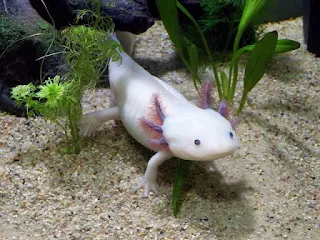What Do Axolotls Eat? A Complete Guide to Feeding Your Aquatic Friend
If you’re enchanted by the otherworldly charm of axolotls, you’re not alone. These fascinating amphibians, often called “water monsters” or “Mexican walking fish,” captivate enthusiasts with their unique appearance and endearing personalities.
However, as a responsible axolotl owner, one of the most crucial aspects of care is ensuring they receive a proper diet. So, what exactly do axolotls eat?
Let’s explore everything you need to know about feeding these aquatic wonders.
Understanding Axolotl Diet Basics
Before delving into the specifics of an axolotl’s diet, it’s essential to grasp their dietary requirements.
Axolotls are carnivores, meaning they primarily consume meat. In their natural habitat of lakes and canals in Mexico, axolotls feast on various small prey, including insects, crustaceans, worms, and small fish.
In captivity, replicating this diet is crucial for their health and well-being.
Feeding Frequency
Axolotls are not voracious eaters like some other pets. They have relatively slow metabolisms and can thrive on a modest feeding schedule.
Offering food once a day or every other day is typically sufficient for adult axolotls. Juveniles may require more frequent feeding, up to twice daily, to support their growth and development.
Suitable Axolotl Foods
Live Foods: Axolotls strongly prefer live prey. Small earthworms, bloodworms, blackworms, and daphnia are excellent choices. These live foods provide essential nutrients and stimulate the axolotl’s natural hunting instincts.
Frozen Foods: If live prey is not readily available, frozen alternatives can be a convenient substitute. Frozen bloodworms, brine shrimp, and mysis shrimp are popular among axolotl enthusiasts. Thaw frozen foods thoroughly before offering them to your axolotl.
Pellets: High-quality axolotl pellets can serve as a staple diet or supplement to live and frozen foods. Look for pellets formulated explicitly for axolotls or aquatic carnivores. Avoid pellets designed for fish, as they may not meet the nutritional needs of axolotls.
Occasional Treats: Variety is vital to a balanced diet. As an occasional treat, you can offer your axolotl small pieces of lean, unseasoned cooked meats, such as shrimp, fish, or chicken. Ensure the portions are small enough to prevent choking and remove any uneaten portions promptly.
Foods to Avoid
While axolotls are not particularly picky eaters, certain foods should be avoided as they can be harmful or difficult to digest:
Large Prey: Avoid offering prey items too large for your axolotl to consume comfortably. This can lead to choking or digestive issues.
Insects Treated with Pesticides: If insects are collected from the wild or purchased, ensure they have not been exposed to pesticides or other harmful chemicals.
Feeder Fish: While fish like goldfish or guppies are commonly used as axolotl food, they risk introducing diseases or parasites to your axolotl tank. Additionally, some feeder fish may contain thiaminase, an enzyme inhibiting vitamin B1 absorption in axolotls over time.
Processed Foods: Avoid feeding your axolotl processed foods intended for human consumption, such as bread, cereal, or processed meats. These foods lack the essential nutrients axolotls need and can lead to health problems if consumed regularly.
Feeding Techniques
When offering food to your axolotl, there are a few techniques to ensure they receive their meal safely and efficiently:
Hand Feeding: Some axolotls can be trained to hand feed, which allows you to monitor their food intake more closely and build a stronger bond with your pet. Use feeding tongs or your fingers to present the food near your axolotl’s mouth, taking care not to startle or stress them.
Feeding Dish: Placing food in a shallow dish or container can help prevent the substrate from becoming contaminated with uneaten food, making cleanup easier. Ensure the dish is easy to access for your axolotl and remove any uneaten food after feeding to maintain water quality.
Target Feeding: If you have multiple axolotls or other tank inhabitants, target feeding can help ensure each individual receives their own food. Use a feeding tube or syringe to deliver food directly to each axolotl, minimizing competition and aggression during feeding.
Monitoring Your Axolotl’s Health
Regular observation is crucial for detecting changes in your axolotl’s behavior or appearance that may indicate health issues.
Signs of a healthy axolotl include alertness, smooth skin, clear eyes, and active swimming.
If you notice abnormalities such as loss of appetite, lethargy, or unusual growths, consult a veterinarian with experience in exotic pets for proper diagnosis and treatment.
Conclusion
Feeding your axolotl a nutritious and varied diet is essential for their overall health and vitality.
By understanding their dietary needs and preferences, you can provide your aquatic friend with a diet that promotes growth, enhances coloration, and supports their natural behaviors.
Remember to offer a mix of live, frozen, and pellet foods, and avoid feeding potentially harmful or inappropriate items.
With proper care and attention to their nutritional requirements, your axolotl can thrive for many years, delighting you with their unique charm and beauty.
So, the next time you feed your axolotl, take pride knowing you’re providing them with the nourishment they need to flourish in their underwater world.
Happy feeding, and may your axolotl enjoy many delicious meals ahead!

.jpg)
Comments
Post a Comment